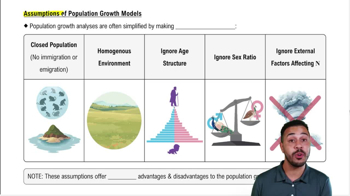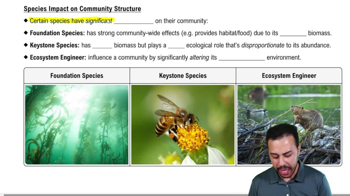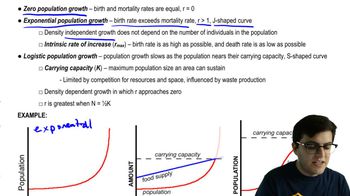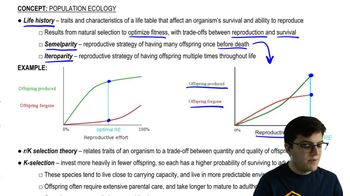Table of contents
- 1. Introduction to Biology2h 40m
- 2. Chemistry3h 40m
- 3. Water1h 26m
- 4. Biomolecules2h 23m
- 5. Cell Components2h 26m
- 6. The Membrane2h 31m
- 7. Energy and Metabolism2h 0m
- 8. Respiration2h 40m
- 9. Photosynthesis2h 49m
- 10. Cell Signaling59m
- 11. Cell Division2h 47m
- 12. Meiosis2h 0m
- 13. Mendelian Genetics4h 41m
- Introduction to Mendel's Experiments7m
- Genotype vs. Phenotype17m
- Punnett Squares13m
- Mendel's Experiments26m
- Mendel's Laws18m
- Monohybrid Crosses16m
- Test Crosses14m
- Dihybrid Crosses20m
- Punnett Square Probability26m
- Incomplete Dominance vs. Codominance20m
- Epistasis7m
- Non-Mendelian Genetics12m
- Pedigrees6m
- Autosomal Inheritance21m
- Sex-Linked Inheritance43m
- X-Inactivation9m
- 14. DNA Synthesis2h 27m
- 15. Gene Expression3h 20m
- 16. Regulation of Expression3h 31m
- Introduction to Regulation of Gene Expression13m
- Prokaryotic Gene Regulation via Operons27m
- The Lac Operon21m
- Glucose's Impact on Lac Operon25m
- The Trp Operon20m
- Review of the Lac Operon & Trp Operon11m
- Introduction to Eukaryotic Gene Regulation9m
- Eukaryotic Chromatin Modifications16m
- Eukaryotic Transcriptional Control22m
- Eukaryotic Post-Transcriptional Regulation28m
- Eukaryotic Post-Translational Regulation13m
- 17. Viruses37m
- 18. Biotechnology2h 58m
- 19. Genomics17m
- 20. Development1h 5m
- 21. Evolution3h 1m
- 22. Evolution of Populations3h 52m
- 23. Speciation1h 37m
- 24. History of Life on Earth2h 6m
- 25. Phylogeny2h 31m
- 26. Prokaryotes4h 59m
- 27. Protists1h 12m
- 28. Plants1h 22m
- 29. Fungi36m
- 30. Overview of Animals34m
- 31. Invertebrates1h 2m
- 32. Vertebrates50m
- 33. Plant Anatomy1h 3m
- 34. Vascular Plant Transport2m
- 35. Soil37m
- 36. Plant Reproduction47m
- 37. Plant Sensation and Response1h 9m
- 38. Animal Form and Function1h 19m
- 39. Digestive System10m
- 40. Circulatory System1h 57m
- 41. Immune System1h 12m
- 42. Osmoregulation and Excretion50m
- 43. Endocrine System4m
- 44. Animal Reproduction2m
- 45. Nervous System55m
- 46. Sensory Systems46m
- 47. Muscle Systems23m
- 48. Ecology3h 11m
- Introduction to Ecology20m
- Biogeography14m
- Earth's Climate Patterns50m
- Introduction to Terrestrial Biomes10m
- Terrestrial Biomes: Near Equator13m
- Terrestrial Biomes: Temperate Regions10m
- Terrestrial Biomes: Northern Regions15m
- Introduction to Aquatic Biomes27m
- Freshwater Aquatic Biomes14m
- Marine Aquatic Biomes13m
- 49. Animal Behavior28m
- 50. Population Ecology3h 41m
- Introduction to Population Ecology28m
- Population Sampling Methods23m
- Life History12m
- Population Demography17m
- Factors Limiting Population Growth14m
- Introduction to Population Growth Models22m
- Linear Population Growth6m
- Exponential Population Growth29m
- Logistic Population Growth32m
- r/K Selection10m
- The Human Population22m
- 51. Community Ecology2h 46m
- Introduction to Community Ecology2m
- Introduction to Community Interactions9m
- Community Interactions: Competition (-/-)38m
- Community Interactions: Exploitation (+/-)23m
- Community Interactions: Mutualism (+/+) & Commensalism (+/0)9m
- Community Structure35m
- Community Dynamics26m
- Geographic Impact on Communities21m
- 52. Ecosystems2h 36m
- 53. Conservation Biology24m
50. Population Ecology
Introduction to Population Ecology
Problem 13b
Textbook Question
Textbook QuestionBurmese pythons (Python molurus bivittatus) are constricting snakes that can reach enormous sizes (up to 7 meters in length). They are native to Southeast Asia but were released into southern Florida from the pet trade. Many other snakes occur naturally in this area. Are the introduced pythons a problem? The data in the graph show the number of pythons that were encountered, not the total number of pythons in the population. Design a mark–recapture experiment to estimate the total population size of pythons, and list at least two assumptions you would be making in your experiment.
 Verified step by step guidance
Verified step by step guidance1
Step 1: Understand the concept of a mark-recapture experiment. This is a method commonly used in ecology to estimate an animal's population size. A portion of the population is captured, marked, and released. Later, another portion is captured and the number of marked individuals within the sample is counted.
Step 2: Design the experiment. First, capture a sample of pythons from the population. Mark these pythons in a way that does not harm them or affect their behavior, such as with a non-toxic paint or a small tag. Release these marked pythons back into the population.
Step 3: After a certain period of time, capture another sample of pythons from the population. Count the number of marked and unmarked pythons in this second sample.
Step 4: Use the proportion of marked to unmarked pythons in the second sample to estimate the total population size. The formula for this is: (number of marked pythons in first sample/total population size) = (number of marked pythons in second sample/size of second sample). Solve this equation for the total population size.
Step 5: Identify assumptions. Two assumptions you would be making in this experiment are: 1) The marked pythons have mixed completely with the rest of the population between the time of the first and second sample. 2) No marked pythons have died, migrated out of the area, or been born between the two samples.
Recommended similar problem, with video answer:
 Verified Solution
Verified SolutionThis video solution was recommended by our tutors as helpful for the problem above
Video duration:
1mPlay a video:
Was this helpful?
Key Concepts
Here are the essential concepts you must grasp in order to answer the question correctly.
Mark-Recapture Method
The mark-recapture method is a technique used in ecology to estimate the size of wildlife populations. It involves capturing a sample of individuals, marking them, and then releasing them back into their habitat. After some time, a second sample is captured, and the number of marked individuals within this sample is used to estimate the total population size using statistical formulas.
Recommended video:
Guided course

Mark & Recapture: Calculations & Assumptions
Population Assumptions
When conducting a mark-recapture experiment, certain assumptions must be made for the results to be valid. Two key assumptions are that the marked individuals mix evenly with the unmarked population and that there are no significant changes in the population size due to births, deaths, immigration, or emigration between the two sampling events. These assumptions ensure that the captured samples are representative of the entire population.
Recommended video:
Guided course

Assumptions of Population Growth Models
Ecological Impact of Invasive Species
Invasive species, such as the Burmese python in Florida, can have significant ecological impacts on native wildlife and ecosystems. They often outcompete native species for resources, disrupt food webs, and can lead to declines or extinctions of local species. Understanding these impacts is crucial for assessing the problem posed by introduced species and for developing management strategies.
Recommended video:
Guided course

Species Impact on Community Structure

 1:17m
1:17mWatch next
Master Population Ecology with a bite sized video explanation from Jason Amores Sumpter
Start learningRelated Videos
Related Practice



































































